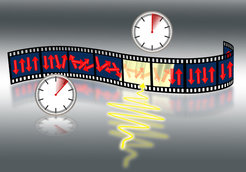Turning back time by controlling magnetic interactions
Researchers at the Max Planck Institute for the Structure and Dynamics of Matter lay the theoretical foundation for more efficient magnetic storage

Exchange interactions
The strongest interactions in magnetic materials are called exchange interactions since they are caused by the exchange of electrons between individual microscopic magnets, called spins. A spin can feel a force from its neighbor that is up to a hundred times larger than the magnetic fields available in the laboratory. Johan Mentink and collaborators have shown that the electric field of the laser can influence the electrons during this exchange process and thus modify the interaction. Owing to the strength of the exchange interactions, this holds the promise to achieve a control of magnetism on the fastest possible timescale, with high relevance for technological applications such as magnetic storage.
Rapid and reversible
While it has been demonstrated before that exchange interactions can be modified very rapidly, the ultimate control of exchange interactions would be achieved when one can selectively strengthen or weaken the interactions when the electric field is turned on and off, for example. This has now been demonstrated by exposing the magnetic material to a time-periodic electric field that is deliberately tuned to avoid a direct excitation of the electrons. Interestingly, even for the model system considered, this protocol already displays a rich control: the exchange interaction can be enhanced, weakened, and even reverse sign, thus favoring parallel instead of anti-parallel alignment of neighboring spins.
Turn back time
Quite surprisingly, upon changing the sign of the exchange interaction by the periodic electric laser field, it was observed that the spin dynamics turns back time. Mentink: ‘This demonstration caused a lot of excitement during our studies. Intuitively, one expects that a sign change of the interaction causes a rapid change of the magnetic state, but we find instead that the spins evolve back to their original orientation without any signature of a different magnetic state’. As a result, our studies do not only have high relevance for technological applications, but also for fundamental studies on the time-reversibility of quantum systems.

